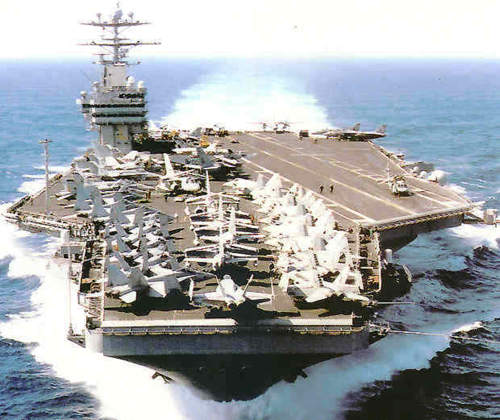Naval supremacy is one of the oldest forms of national power projection. For millennia, the ability to operate beyond a country’s coastal waters has provided nations with greater security. In modern times, aircraft carriers exponentially multiply maritime supremacy. They provide navies with floating bases, thereby extending range and relinquishing dependence on foreign governments. Both practically and symbolically, the aircraft carrier has been central to American power projection in the time since WWII during which it has dominated the Pacific. However, these vessels are now vulnerable to China’s vast new array of missiles.
Throughout the history of carrier aviation, it has been said that one of the first things asked during times of crisis is: “Where is the nearest aircraft carrier?” The U.S. has had a naval presence, including carriers, in the Pacific for over half a century since its defeat of Japan in World War II. It has used its unmatched naval power to implement a rules-based international system based on free trade, freedom of navigation, and democracy. This dominance was accelerated in 1972 when U.S. President Richard Nixon visited China, thereby formally normalizing relations between the two nations.

While there has always been Chinese opposition to American naval dominance in the Pacific, it is difficult to argue against the notion that it has had a direct link to China’s modern stability and prosperity. That said, many proponents of Chinese ambition assert that America’s role in the Pacific is crumbling. This is especially true as China attempts to recast its ancient military and political might.
Today, China is especially concerned about the security of its seaborne commerce in the coastal waters that include the Yellow, East China, and South China Seas. As such, China is beginning to implement a strategy to increase control over these Near Seas, pushing the U.S. Navy (USN) farther from its coasts. In doing so, China is launching a profound challenge to the backbone of America’s modern economic success.
American military strategists assert that for the past 20 years China has been expanding its military with a keen focus on investments in its “anti-navy” – a series of warships, silent submarines, and precision missiles specifically designed to prevent the USN from operating in large areas in the northwestern Pacific Ocean. As Dennis Blair, a retired U.S. Navy admiral who was the commander of U.S. forces in the Pacific region states: “Ninety per cent of [China’s] time is spent on thinking about new and interesting ways to sink our ships and shoot down our planes.”
Some observers believe China wants its naval capabilities to perform as an anti-access/area-denial (A2/AD) force — a force that can deter U.S. intervention in a conflict in China’s Near Seas region, or at minimum reduce the effectiveness of intervening U.S. forces. That said, China currently only has one aircraft carrier in its possession
The U.S. Pacific Fleet, on the other hand, is the world’s largest fleet command, surveying an area of 160 million square kilometres, and consisting of approximately 200 ships/submarines. Of these, two are aircraft carriers.

The U.S. has not lost an aircraft carrier since the Japanese sank the USS Hornet during the Battle of the Santa Cruz Islands in 1942. Today, the mere thought of a vulnerable carrier could be enough to restrict its use, as its loss would be an unfathomable defeat to American naval prestige and credibility. These sentiments are beginning to be realized in the Pentagon, as a new concept of fighting wars at sea is beginning to take shape.
AirSea Battle, inspired by the AirLand Battle concept, is an integrated conflict doctrine that became part of U.S. grand strategy in February 2010. Its purpose is to confirm U.S. military power to address asymmetrical threats stemming from China and Iran.
By weakening the U.S. Navy’s presence in the Pacific, China hopes this will impede America’s ability to support treaty allies in the region – i.e. Japan and the Philippines. If China is successful, this will reshape the balance of power in the region. If U.S. influence does indeed decline, China would be in a position to assume quietly a leadership position in Asia, giving it much greater sway over the rules and practices in the global economy.




